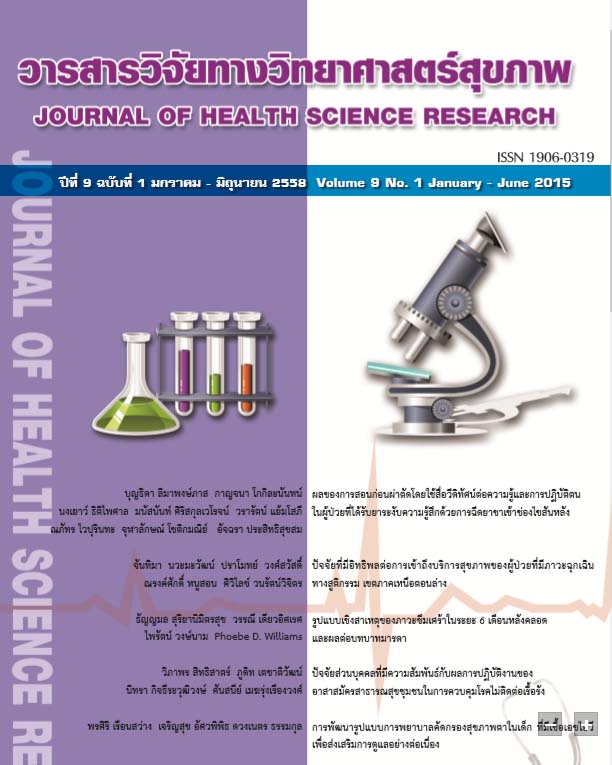การพัฒนารูปแบบการพยาบาลคัดกรองสุขภาพตาในเด็กที่มีเชื้อเอชไอวี เพื่อส่งเสริมการดูแลอย่างต่อเนื่อง Eye screening nursing model for children with HIV infection to promote continuity of care.
Main Article Content
บทคัดย่อ
การวิจัยเชิงปฏิบัติการแบบมีส่วนร่วม เพื่อพัฒนารูปแบบการพยาบาลคัดกรองสุขภาพตาในเด็กที่มีเชื้อเอชไอวี สถาบันบำราศนราดูร ใช้กระบวนการมีส่วนร่วมของทีมสหสาขาวิชาชีพ จำนวน 7 คน ผู้ป่วยเด็กและผู้ปกครอง จำนวน 10 คน ดำเนินการวิจัย 3 ระยะ ได้แก่ 1) ขั้นเตรียมการวิจัย 2) ขั้นดำเนินการวิจัย และ 3) ขั้นติดตามและประเมินผล ผลการวิจัย พบว่า ปัญหาระบบการพยาบาลคัดกรองสุขภาพตาในเด็กที่มีเชื้อเอชไอวี ยังมีความบกพร่องของการประสานงานระหว่างทีมสหสาขาวิชาชีพ ผู้ปกครองขาดประสบการณ์ ความรู้ ความเข้าใจถึงปัญหาที่เกิดขึ้น พบเด็กสูญเสียดวงตาอย่างถาวร สายตาสั้น ฯลฯ ขั้นพัฒนารูปแบบ พบว่ามี 5 องค์ประกอบดังนี้ 1) การคัดกรองสุขภาพตา 2) การวัดสายตาเบื้องต้นโดยพยาบาล 3) เกณฑ์การส่งต่อเพื่อตรวจตากับจักษุแพทย์ 4) การติดตามผลการตรวจที่ห้องตา และ 5) เด็กที่มีเชื้อเอชไอวีได้รับการตรวจตาอย่างต่อเนื่อง โดยผู้ปกครองร่วมรับรู้และร่วมแก้ไขปัญหา ระยะประเมินประสิทธิภาพ กับผู้รับบริการ จำนวน 168 คน พบว่าเด็กได้รับการพยาบาลคัดกรองสุขภาพตา และได้รับการตรวจสุขภาพตาโดยจักษุแพทย์เพิ่มขึ้น ผู้ปกครองและเด็กได้รับความสะดวกสบายในการบริการเพิ่มมากขึ้น นอกจากนี้ทีมสหสาขาวิชาชีพสามารถให้บริการอย่างเป็นระบบ และมีความพึงพอใจในระดับดีมาก รูปแบบการพยาบาลที่เกิดขึ้นช่วยเพิ่มประสิทธิภาพการพยาบาลคัดกรองสุขภาพตาแก่เด็กเอชไอวี/เอดส์ในสถาบันฯ ได้อย่างมีประสิทธิภาพอย่างต่อเนื่องและยั่งยืน
Abstract
This participatory action research to improve eye screening methods in children with HIV at Bamrasnaradura Infectious Diseases Institute included a multidisciplinary team of 7 professionals and 10 child patients and their parents. The research was conducted in 3 phases, 1) Preparation, 2) Conducting research and 3) Follow-up and evaluation. Results showed that hospitals’ eye screening methods for child patients with HIV lacks coordination between disciplines and parents’ knowledge and experience pertaining to the problem. Unnecessary permanent loss of eyesight and other difficulties happened. For improvement development of procedures comprises. 5 factors, 1) Eye screening checks, 2) Preliminary eyesight examination conducted by nurses, 3) Criteria for referral to ophthalmologists 4) Follow up of results at ophthalmology department, and
5) Continued eye check-ups. Performance evaluation on 168 patients found that a multidisciplinary team is able to provide systematic care, and high levels of satisfaction with more children undergoing eye screening and examination by ophthalmologists, and child patients and their parents receive better service. The proposed patient care methods can improve screening efficiencies in child patients with HIV/AIDS.
Downloads
Article Details
บทความที่ได้รับการตีพิมพ์เป็นลิขสิทธิ์ของวิทยาลัยพยาบาลบรมราชชนนี จังหวัดนนทบุรี
ข้อความที่ปรากฏในบทความแต่ละเรื่องในวารสารวิชาการเล่มนี้เป็นความคิดเห็นส่วนตัวของผู้เขียนแต่ละท่านไม่เกี่ยวข้องกับวิทยาลัยพยาบาลบรมราชชนนี จังหวัดนนทบุรี และคณาจารย์ท่านอื่น ในวิทยาลัยฯ แต่อย่างใด ความรับผิดชอบองค์ประกอบทั้งหมดของบทความแต่ละเรื่องเป็นของผู้เขียนแต่ละท่าน หากมีความผิดพลาดใด ๆ ผู้เขียนแต่ละท่านจะรับผิดชอบบทความของตนเองแต่ผู้เดียว


